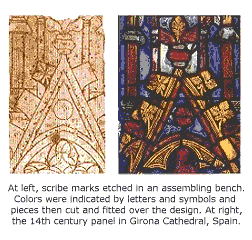
Gothic Design
Learn More.
| HOME Feature Articles Stone Carver's Tour Virtual Cathedral Cathedral Tours Gothic Field Guide GOTHIC GEOMETRY Virtual Abbey Medieval Art Tours Castle Tours Links Resources About The Site FAQ |
|
Painting With Light: Tools & Techniques
It was a 12th century glass painter, Theophilus, in his work 'On Diverse Arts' who first explained the practical techniques little changed over the centuries: "…if you want to assemble simple windows, first mark out the dimensions of their length and breadth on a wooden board, then draw scroll work or anything else that pleases you, and select colors that are to be put in. Cut the glass and fit the pieces together with the grozing iron. Enclose them with lead cames...and solder on both sides. Surround it with a wooden frame strengthened with nails and set it up in the place where you wish…" Simple? In the early Middle Ages, glass was expensive as it was rare, and made only in small quantities. It was provided by glassmakers who usually set up shop at the edges of forests where sand for glass making, and wood for the kilns, could be easily obtained. Back
at the construction site, glaziers cut the raw sheet glass into
pieces used in creating the windows. First,
the subject of the panel was agreed upon by the donor of the window,
from which a
glazier would prepare a sketch. This then became a full sized
"cartoon" and transferred to a large bench that served as a template
for assembly. A red hot iron was used to cut a rough shape, with a final cut made by a hooked shaped tool - the grozing iron. Then the actual painting of each piece of glass was completed, with lines and shading done in black. Finally, pieces were fired in a kiln to fuse the design to the glass. The final assembly was done back on the table, with larger panels supported by iron saddle-bars to strengthen them.
Since bigger windows were more costly, Besides being cheaper, grisailles made interiors even lighter, albeit less dramatic. A later addition to the glazier's pallet was silver stain which resulted in colors from light yellow to a warm gold. The
whole process - from conception to final installation - took many
highly skilled craftsmen, working under the watchful eye of the
master glass painter...
|
Sponsored
Links
copyright © 2017

 The
template included all the calmes lines (the lead) which were,
in turn, shaped to the pieces of glass that made up the painting.
The
template included all the calmes lines (the lead) which were,
in turn, shaped to the pieces of glass that made up the painting. increasing
use was made of a clear or grey glass with simple repeated designs
known as grisaille (from the French, for grey).
increasing
use was made of a clear or grey glass with simple repeated designs
known as grisaille (from the French, for grey).